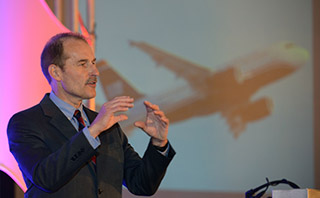Everyone knows the story of US Airways Flight 1549, known as the “Miracle on the Hudson,” the passenger airliner that made an emergency landing on the Hudson River under freezing conditions in January 2009, without losing any of its 150 passengers or five crew. But was it really a miracle or a safety crisis plan carried out almost to perfection with a little luck thrown in for lagniappe?
Capt. Jeff Skiles, who was Sully Sullenberger’s co-pilot aboard the Airbus A320 that day, said the airline industry went through a culture change in the early 1990s, whereby pilots had to accept the value of other employees. It wasn’t the pilots as individuals and then everyone else.
“It was about people giving us the right tools and this amazing safety environment in the airline industry,” said Skiles, who delivered the keynote address at yesterday's WorkBoat Maintenance & Repair Conference and Expo in New Orleans. “The pilot alone doesn’t fly an airliner. A crew flies an airliner. Everyone does their job.”
Trouble started as the plane, with Skiles at the controls, left New York’s LaGuardia Airport on its way to Charlotte, N.C. When the plane reached 3,000', it flew through a flock of geese. Each jet engine took two of the four-pound avian projectiles, travelling 200 miles an hour, into its center mass, completely shutting down one engine and crippling the other, which was on fire and mostly useless.
Sullenberger, as senior crewmember, took over the controls while Skiles went through a checklist of what is called for in this type of emergency. “There really wasn’t a list for a problem like this at 3,000 feet. It was for trouble at something like 30,000 feet,” said Skiles. “It was three pages of instructions. I didn’t get all the way through it.”
The control tower called for the airline to come to a heading that lined it up south along the Hudson River. The plane was now losing 1,000 feet per minute. There was no way to get back to LaGuardia, so the tower asked the pilots if they could make it Teterboro Airport in New Jersey. The answer was negative, which left the Hudson River as the only possibility.
They slowed the speed of the plane to 135 knots in preparation for ditching. Luck was with them as the wind was calm, the river was flat and there were no boats in the way. The Airbus went into the water about as smoothly as could be hoped for and was engulfed by the river, then almost immediately the water fell away, leaving the plane bobbing in the freezing river like a cork.
The crew began getting passengers forward as the rear of the plane was sitting further down in the water. “The passengers were a big part of the success of this evacuation,” said Skiles. “Any part of the body in the water ached to the bone.”
By the time the crew got out of the plane, it was surrounded by a myriad of boats and first responders, who were carrying out their own emergency plans.
As Skiles looks back on that day, he said crew training was the key to success. He said he and Sullenberger were on the same page throughout the crisis. “We knew exactly what was in each other’s head,” he said.




